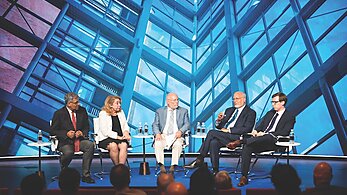Illustration by Bartosz Kosowski
Last Word: Busting the “Greedflation” Myth

re greedy corporations really behind America’s inflation? According to a 2023 YouGov poll, 90 percent of Americans think so. They blame profit-seeking businesses (at least in part) for the rise in prices, making corporations their top scapegoat.
Politicians love this narrative. After all, voters hate paying 25 percent more for groceries than they did in 2020 or facing 7 percent, 30-year fixed mortgage rates today compared to the sub-4-percent pre-pandemic rates. By blaming businesses, elected representatives such as Vice President Kamala Harris, who just released a proposal to ban supposed price gouging by grocery stores, can deflect anger from their own fiscal stimulus measures that helped fuel the inflation.
Their convenient “greedflation” theory suggests that businesses took advantage of expected price rises due to pandemic supply-chain issues and rising energy costs (think Vladimir Putin invading Ukraine) by increasing prices further to puff their profits. The fact that corporate profits did soar in 2021 and 2022, just as inflation spiked, is seen as slam-dunk evidence to support this. Given that companies greenlight their prices, one could argue higher profits caused inflation, right?
Wrong. In fact, this causal claim doesn’t follow logically even from that evidence, nor does this narrative make economic sense.
First, the greedflation story ignores business competition. How could so many firms suddenly command higher profit margins? Corporate concentration didn’t dramatically increase during the pandemic. Firms didn’t magically gain more market power or suddenly become greedier. To believe in greedflation, we’d therefore have to think that businesses across many sectors colluded by using their pricing power to raise prices by limiting their output. But in most industries the urge to undercut rivals and grab market share would undermine this coordination. Moreover, real output actually grew strongly in 2021 and 2022, while inflation surged, thus contradicting the idea that collusive efforts to withhold output was what drove rising prices.
Second, the greedflation tale overlooks consumers. How could customers suddenly afford higher prices across many industries? If businesses in some sectors with price-insensitive customers jacked up prices to puff their profits, those consumers would have less money to spend elsewhere, reducing demand and prices for other goods. This would leave overall inflation largely unchanged. To get a situation in which all prices are rising—a macroeconomic inflation—therefore requires more overall spending, perhaps indicating that there was more money available to spend to begin with.
This points us to the real story: Far from profits driving inflation, inflation and temporarily higher profits were both being driven by a third factor: excessive macroeconomic stimulus.
When the economy reopened from lockdowns, the $6 trillion increase in the money supply and massive pandemic relief from Congress led to a spending frenzy. Spending on final goods and services increased at a whopping average rate of 9.9 percent in 2021 and 2022, well above the usual 3.9 percent rate. This surge in total spending quickly hit production limits and so began driving up prices sharply right across the economy. But for many businesses, retail prices are more flexible than wages and input costs, which are renegotiated infrequently or are locked into contracts. Given the lags in the latter adjusting, this means a temporary profit boost.
Yes, some sectors, such as the petroleum industry, saw soaring profits due to supply shocks, like the higher international gas prices after the Ukraine invasion. This market price rise was useful: It reflected real-world scarcity and helped ration gas to those who needed it most while encouraging American suppliers to expand production to avoid shortages.
The main driver of rising prices since 2020, however, has been the huge growth in total spending, underpinned by excessive stimulus from the Federal Reserve and Congress. Blaming business is simply a convenient means of diverting attention from inflation’s real culprits: policymakers in Washington.





